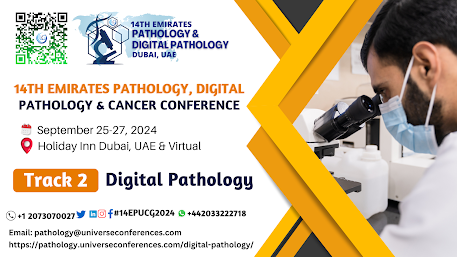TRACK:2 DIGITAL PATHOLOGY
How does one define digital
pathology?
Digital
pathology can be defined as the use of digital technology to create, manage,
analyze, and interpret pathology information. It involves the digitization of
traditional pathology processes, where glass slides containing tissue samples
are converted into high-resolution digital images. These digital images can be
viewed, stored, and shared electronically, providing several advantages over
traditional methods that rely on microscopes and physical slides.
Call For Paper/abstract/case study: https://pathology.universeconferences.com/digital-pathology/
Key components and characteristics of digital pathology include:
1. Digital Slide Scanning: The process of converting glass slides with tissue samples into digital images using specialized scanners. This digitization allows for high-resolution imaging of microscopic details.
2. Image Storage and Management: The organization and storage of digital pathology images in electronic databases. This facilitates easy retrieval, sharing, and collaboration among pathologists and healthcare professionals.
3. Image Viewing and Analysis: The ability for pathologists to view digital pathology images on computer screens, enabling zooming, panning, and detailed analysis. Digital tools and software assist in image interpretation and analysis.
4. Telepathology: The capability to remotely share and access digital pathology images for collaborative purposes, consultations, and second opinions. This supports communication among pathologists regardless of their physical location.
5. Integration with Information Systems: The integration of digital pathology systems with other healthcare information systems, such as electronic health records (EHRs). This integration enhances workflow efficiency and allows for a more comprehensive view of patient data.
6. Advanced Computational Techniques: The potential application of advanced computational methods, such as machine learning and artificial intelligence, for automated image analysis and pattern recognition. These techniques can aid in diagnosis, prognosis, and research.
Digital pathology aims to streamline and modernize traditional pathology practices, offering benefits such as improved workflow efficiency, faster turnaround times, enhanced collaboration, and the potential for more precise and standardized diagnoses. The field is continuously evolving, with ongoing research and development focused on addressing challenges and further optimizing the use of digital technology in pathology.
SUB TRACK: Clinical Digital Pathology, Digital Pathology, primary diagnosis, tele-pathology, cellular structures, scanner, scanner technology, Radiology, Whole-Slide Imaging, microscopy, Glass slides, diagnoses, diagnostic medicine, pathologist, skills, skills quantitative image analysis, machine learning, artificial intelligence, diagnoses for patients, scientist, Digital Pathology Scanner, Virtual Pathology, Next generation diagnostic pathology, Future of Digital Pathology, History of Digital Pathology
Important
Information:
Conference
Name: 14th Emirates Pathology, Digital Pathology & Cancer Conference
Short
Name: 14EPUCG2024
Dates:
September 25-27, 2024
Venue:
Holiday Inn Dubai, UAE & Online
Email:
pathology@universeconferences.com
Visit:
https://pathology.universeconferences.com/
Submit
here: https://pathology.universeconferences.com/submit-abstract/
We
have numerous speakers and attendees from all over the world: https://pathology.universeconferences.com/committee-members-and-speakers/
Register
here: https://pathology.universeconferences.com/registration/
Online
Registration here: https://pathology.universeconferences.com/virtual-registration/
Call Us: +12073070027 WhatsApp Us: +442033222718





Comments
Post a Comment